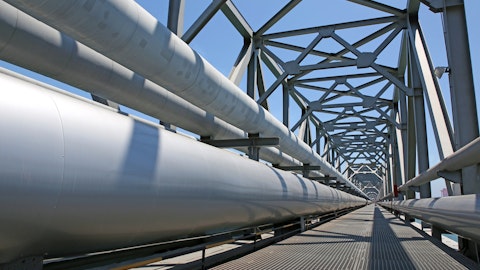Jose Mas: I think it’s two things, I think one is wildfires and the other is storms and I think that when you think about the West Coast, they’ve been more impacted by fires, the East Coast has been more impacted by storms. The fixes for either one are somewhat similar. So, the investments in undergrounding systems, in hardening systems across the country become more and more meaningful as we deal with climate change. So I do think that — those are — the challenge right is who is going to pay for it and what’s — where the states stand in terms of funding these initiatives and where is the cost of power in a particular state and how willing is their Public Service Commission to grant the utility dollars to be able to do it.
We’re based here in Florida and in Florida there has been a huge initiative in the state, the Public Service Commission has passed a 30-year program with tens of billions of dollars of funding to allow the utilities here to do that. I think we’re going to see more of that as time goes on. I think it’s necessary. And I think it’s going to be meaningful across the country, in addition to what’s happening with load growth, right. This helps offset — these investments help you manage some of the issues that are going to come with load growth but they are different and they both need to be dealt with. So these are all catalysts and positive trends that we’re going to see in this industry for a long time.
Neil Mehta: Yeah, important issue. Thank you, Jose.
Jose Mas: Thanks, Neil.
Operator: We will take our next question from Adam Thalhimer with Thompson Davis.
Adam Thalhimer: Hey, good morning, guys. Congrats on the strong Q4 cash flow.
Jose Mas: Thanks, Adam.
Adam Thalhimer: Jose, your comment about double-digit Communications revenue growth next year was interesting, what’s the driver of that again.
Jose Mas: Just that wireless win, right. That contract by itself should allow us to grow double-digits for the full segment next year.
Adam Thalhimer: And then related to that — given that dynamic, what kind of margins do you think you could generate with that kind of revenue growth?
Jose Mas: Improving margins, right, so if we go back a few years, at scale our business has been declining or when you think about our wireline business over the course of last year, it declined, that’s challenging for margins. There’s obviously a start-up phase where we invest in the business, which is kind of baked into the margin profile that we’re expecting for ’24, but with scale, right, the incremental revenue comes at a higher margin. And that’s going to drive margins up. So, that’s a really important part of our ’25 and beyond story as well.
Adam Thalhimer: Great. Thank you.
Jose Mas: Thanks, Adam.
Operator: We will take our next question from Brett Castelli with Morningstar.
Brett Castelli: Thank you. Just on Power Delivery, can you talk about your capabilities today on the transmission side of that business, maybe relative to history?
Jose Mas: Sure, so we — I mean, we actually started that business, I don’t know, now maybe 10, 12 years ago, really focused on the transmission side, that’s where we started. We did some big projects. Wanted to get into the more predictable cadence of the business. So, we really started focusing on distribution. Our efforts in 2021 and ’22 through the acquisitions that we made were really to expand our geographic scope. The primary nature of those acquisitions was also heavy MSA, heavy distribution, although they all add transmission resources available. I think since those acquisitions have made. We’ve really grown and added to our transmission capabilities in terms of talent and capabilities, and I think today, we’re in a position where we’ve done some jobs here in the last two years that are of size and scale and I think we’ve really positioned ourselves to be a significant player in that market for a long time.
Again, in our prepared remarks, we talked about a number of jobs that we’re currently bidding that we feel comfortable and good that we’ll be successful on some and have a meaningful impact to our business. So it’s — that’s probably going to be the biggest growth part of our Power Delivery business over the next couple of years. There is an incredible amount of demand across the country and there’s more coming. So, it’s an important part of where we’re trying to take that business.
Brett Castelli: Thanks, Jose. And then I think you mentioned consolidation of contractors by your customer base in your prepared remarks. Is that maybe more pronounced in certain segment or segments or just kind of curious how you’re seeing that across the business?
Jose Mas: I think it’s actually part of the same comments with scale. So, I think we’re actually seeing it in all of our businesses, right. We see it in the award of our biggest customer in wireless and communications. We’re seeing it with some of the utilities. We did talk about nice awards in our utility business of markets where we feel some of our customers consolidated their vendors. We’re seeing it in the Clean Energy space where developer’s large utilities are using less vendors for the renewable projects portfolios on a go-forward basis. So, we think as projects get bigger, as consolidation happens across our customers as well. People tend to want to work with less partners and we think that’s a really important part of the story.
We think scale matters, we think we’ve built great scale and our customers believe in the scale capabilities that we have and we do think that’s a really important part of what’s going to make companies successful in the future. And that’s really what we’ve been building towards.
Brett Castelli: Thank you. I’ll leave it there.
Jose Mas: Thank you.
Operator: We will take our next question from Justin Hauke with Robert W. Baird.
Justin Hauke: Great. Thanks for taking my questions here. I guess the first one, just truly kind of just a numeric one that I wanted to clarify, in terms of the backlog and what’s in it and what’s not. So I think you said AT&T scope addition was booked in the fourth quarter, but Nokia and Ericsson equipment scope that you’re talking about in the second-half, that’s not in backlog yet. That’ll be when you go into the second half. And then the other numeric on that aspect will be in the Clean Energy, I think you said that you de-booked the Rochester job that was $200 million. I’m just curious if there were any other significant de-bookings in the quarter in that segment as you kind of scrub the backlog.
Jose Mas: There was no other de-bookings. Obviously, we announced the issues with that project in the third quarter and the lifecycle project is on hold. So we’ve taken it out of backlog. It was a project that we’ve been working on. So, typically, once the project his backlog, usually we build it, there are very few instances where we’ve had to take anything out of backlog, obviously lifecycle was its own — had its own issues. When we think about comps, a portion of it is in backlog. I think that, again, we’re not expecting significant impact from that until the latter part of the year and again that’s — our backlog is, we only take the 18-month view. So, there is a component for that, but it’s a relative — we think a much smaller component than what the actual award means over the long term.
Justin Hauke: Okay and then I guess my second question is just, maybe it’s another numeric one, but just kind of quantifying, the Illinois and the Exelon impact in the Power Delivery business, I guess — I didn’t realize that was such a big geography for you. So, maybe you can just give some context to the 2024 guidance assumes like 2% growth for that segment. How much is the Illinois rate case weighing on the revenue growth outlook there?
Jose Mas: So, I’d say a couple of things. Exelon was — is our fourth largest customer at MasTec. So it’s not all in Illinois, but it’s — a good chunk of it is. They have a meaningful cut for ’24. We originally talked about mid-single-digit revenue growth in this market for ’24 versus what we’re saying today and I think that entire drop is the impact. So if you want to call it $100 million, $150 million of impact in ’24, that’s kind of what we’ve built in, assuming we don’t — we’re not able to — really put those people on other work, which I think there’s going to be an opportunity for. So again, we talked about it being somewhat of a conservative view, but that’s our view today. So, we’ve kind of taken the entire impact that we expect in ’24 completely out of guidance.
Justin Hauke: Got it. Okay. Thank you. Appreciate it.
Jose Mas: Thanks, Justin.
Operator: We will take our next question from Brent Thielman with D.A. Davidson.
Brent Thielman: Pretty close. Hey, Jose, Paul, just on the $550 million cash from operations bogey, could you talk about the puts and takes that could get you potentially above that this year just given you had a pretty strong finish to 2023?
Paul DiMarco: Yeah, this is Paul. I think the biggest driver is just around the DSO. So I said, we’re assuming we kind of spend the year in the high 70s, versus the ’74 we ended the year at. So, I think there’s some opportunity for us to continue to perform better from a DSO perspective and the revenue levels we’re generating each day is north of $30 million of cash flow. So, that’s a pretty meaningful opportunity.
Brent Thielman: Yeah, great and then just back to Clean Energy, Jose, could you just speak to the margin profile, the structure of the contracts, anything else to the new business that you’re adding into the backlog at this point and maybe how that all informs your view around higher levels of profitability for that business group kind of over the medium-term. I know you’ve got your expectation for this year but kind of looking out beyond that.
Jose Mas: Yeah, look, it’s a great question. One, obviously as ’23 played out and even a little bit into early ’24, we’re still working on our contracts that were won a while ago. Obviously, everybody knows the challenges that have existed with supply chain. So, as you’re working on older projects, those businesses sometimes it has negative impact to margins. Historically and even as we look at our ’23 performance, our wind’s margins significantly outperformed our solar margins, that has everything to do with the fact that we’ve been deploying for a long time and we’re a lot newer to solar. We’ve got a ton of opportunity to increase our solar margins which we need to do and we need to accomplish. I think that’s going to be the bigger driver of the margin growth over time.
But wind margins quite frankly are holding with what we’ve historically done. So, as the wind market comes back and as that becomes a bigger driver of revenues. We do think that the margin profile there is considerably at least from our performance perspective, considerably better. If you go way back, we used to — there were years where this business performed at double-digits solar segment, a lot of that was driven by wind. We’re seeing similar margin potentials in some of those projects on a go-forward basis. We’ve got to get our solar business there over time, which is what we’re working on, obviously, the solar business is what’s going to grow faster. So, we’re encouraged, ’23 again was a tough year. We’re going to have ups and downs in ’24, we kind of built that into our model, but I really think that our focus today is on executing these projects and driving margins out-of-the business and our goal, our objective is really to increase those margins over time.
Brent Thielman: Okay. Thank you.
Jose Mas: Thanks.
Operator: We will take our next question from Min Cho with B. Riley Securities.
Min Cho: Hi. Good morning.
Jose Mas: Hi, Min.
Min Cho: Couple of quick questions. Hey there. In terms of, Paul, you mentioned that you’re breaking out the Clean Energy section into several market sectors. Can you provide a general revenue breakout right now like the renewables versus Infrastructure Industrial stand?
Paul DiMarco: Yeah, our renewables business is just over 60% of the total segment.
Min Cho: Okay. That’s obviously where all the growth potential is going forward.
Paul DiMarco: Yeah, I mean, infrastructure has got some good opportunities as well. Right, I mean, so that business had a meaningful — both our legacy and IEA had good scale in that business in different geographies, and with the Infrastructure bill , there are a number of opportunities there as well. We have deemphasized industrial in the near term, just in light of some of the challenges we had on projects over ’21 and in the latter part of ’23. So, I do think there is — yeah, renewables will, for sure, drive the growth but infrastructure has got some good opportunities as well.
Min Cho: Excellent. That’s very helpful. And then just finally, obviously, Jose, you’ve been scaling up kind of with expectations for growth for the next couple of years and it sounds like there is so much more growth to come. We’re just at the very beginning and across all of your end markets and labor, it’s always an issue, continues to be an issue, but when do you think the industry gets to kind of a full capacity where you start to see elongation of the cycles where it really benefits margins?
Jose Mas: I think each segment is different. I think in some segments, quite frankly, we’re almost there. I think one of the really important things is customers recognize it right, they talk about it. They don’t necessarily feel it yet, because they know they’re still flex in the system, but everybody knows we’re going to get to that point. I think coming out of ’24 into ’25, across all of our segments, we going to fuel some of that. Some more than others and, I do think that at that point, it does start impacting, what we do with customers, how we talk about it, and how we price things.
Min Cho: Excellent. All right. Well, good luck to you in 2024. Thank you.
Jose Mas: Thanks, Min.
Operator: We currently do not have any further questions. I will turn it back to Mr. Mas for closing remarks.
Jose Mas: Just want to thank everybody for participating today and we look forward to updating you on our first quarter call here in short period of time. Thank you.
Operator: This concludes today’s call. Thank you for your participation. You may now disconnect.
Follow Mastec Inc (NYSE:MTZ)
Follow Mastec Inc (NYSE:MTZ)
Receive real-time insider trading and news alerts


